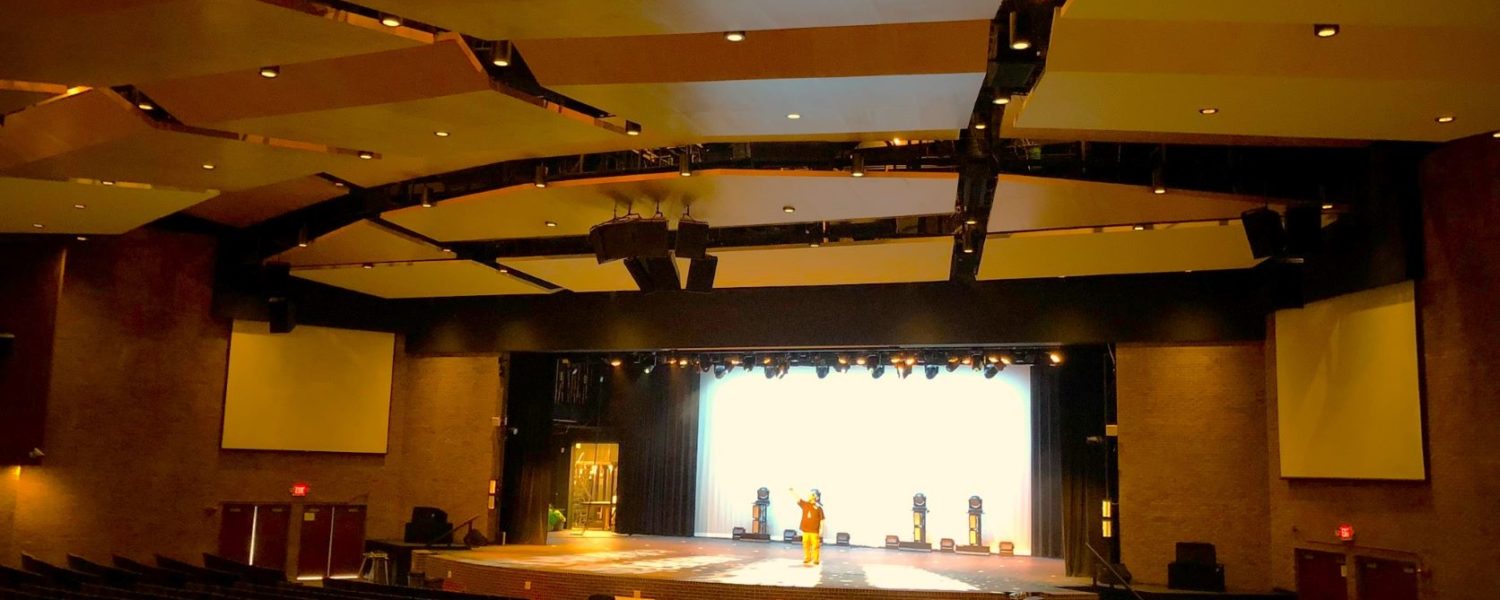By Scott Kinnebrew
Be it a school-wide gathering, student performance, leadership meeting, or community-related event, the stages in our schools serve a multitude of purposes. The essential parts of an effective stage are lighting, sound, video, power, soft goods and expendables, with each category responsible for making sure the audience feels as connected as they can to the event.
Making decisions on what will work best can be an intimidating task, but understanding the basics of what’s needed and doing a bit of research will help you choose the right products.
Lighting
Lighting illuminates, enhances, and sets the stage. Choosing the right lighting products and deciding on their placement can be daunting, but doing so will make every event unforgettable. Traditional lighting like ellipsoidals, pars, and fresnels are still essentials of the stage today, but now more and more are using LEDs instead of lamps. This means less heat, lower power, and no lamp changes.
Intelligent lighting products, referring to DMX controllable fixtures, have found their way onto more and more stages, making positioning and focus much easier. This means less time on ladders and more time working on other things. Wash lights, selected for their wide angles, give good coverage of large areas. Spot fixtures, designed for projecting sharp edges, come with a multitude of features that make them very useful on the modern stage.
Additionally, there are more “specialized” lighting products like beams, haze and fog machines, special effect lights, and gobo projectors that can bring custom images and specific looks to your stage. There are many considerations when choosing your lighting (stage size, ceiling height, rigging locations), all of which are contributing factors to getting the most out of your fixtures.
Sound
Like lighting, sound is an essential part of any stage. A combination of the right solutions will make sure that any message that is being presented will be captured and amplified to your audience.
Microphones are essential to capturing sound, and selection and placement are key to making sure everyone on the stage is heard. Overhead or choir microphones work well for capturing groups. Individuals or soloists project much better through a handheld type, headset, or lavalier microphone. Wireless microphones eliminate the use of cables on the stage and also give the performers freedom to move around.
In addition to microphones, it’s important to have connections on the stage for instruments, MP3 players, cell phones, or laptops. Filling a room with sound is important, and taking things into account (size of the space, acoustical treatments, what will be played through it, surround sound) will help you decide how much power and what type of system you’ll need to fill the room with sound.
Video
The technological advancements in video over the past 10 years have made incorporating it into your stage easier than ever before. Today’s projectors are much smaller, brighter, and more power efficient than ever before, making them a great choice. Direct view LED (dvLED) walls are also finding their way onto more and more stages as a video solution as components get more and more affordable.
Both projection and LED have become widely used not only for performance-related purposes but have also proven very useful in schools for presentations, student AV projects, and other events needing to be viewed by large groups. There are two things to remember when making a decision on video products: projectors will create shadows on the screen and dvLED will not, and you should always select products that are easy to use and easy to connect.
Power
With so many devices needing electricity on our stages, proper power distribution is key. Electricity can be a scary thing to worry about, and stage electricity requires more than just wall outlets. Working with a specialist that understands the needs of the stage will make sure all of your gear will have clean, reliable power. Relays, Dimmers, L-620, Edison, Stage Pin…there’s a whole book of terms related to power that may seem foreign to you. Working with a specialist will ensure you’ll have enough power for everything, and it’s all done safely. Also, the more advanced the technology is on your stage, the more you want to provide proper power for those devices.
Soft Goods
Soft goods are an essential part of any stage. From the smallest elementary school to the largest performance halls, “curtains” are an essential part of any stage. In the simplest terms, stage curtains are large decorative fabric pieces used to conceal the various parts of the stage from the audience, but they can also be used to create special effects, separate different sections of the stage, be made of a fabric designed specifically for projection or other purposes, and assist with the acoustics of the stage. Each system is made up of parts whose names might not be familiar to you (like grand drape, grand valance, travelers, and side curtains), but don’t let that intimidate you. Working closely with a company that specializes in different types of curtains will provide not only a design that works perfectly for your stage but one that looks great, as well.
Expendables
Last but not least are the expendables. Your stage will undoubtedly need them at some point, be it light bulbs, tape, tie line, paint, haze or fog fluids, work gloves, cables, batteries, or gobos. You eventually are going to run out of something, and, unfortunately, it will be at the worst time, as these products will get used up during an event and need to be replaced. One of the easiest ways to avoid these moments of uncertainty is to find a local stage supply company or online shop to work with that’s an email or a phone call away who can get these items to you quickly in these trying times.
I hope this has given you some things to think about. Whether you are updating your space, replacing non-working items, or just getting gear on your stage for the first time, just know there is a considerable amount of information on the Internet about everything above. And, there are plenty of professionals that specialize in everything stage related, so help is out there. When choosing products, technology is supposed to make our lives easier, not harder, so select them accordingly.
Scott Kinnebrew is in business development for StageSpot, the go-to online resource for stage lighting and live production consumables staffed by production veterans who understand the needs of their customers and the unique circumstances they often find themselves in, www.stagespot.com.





